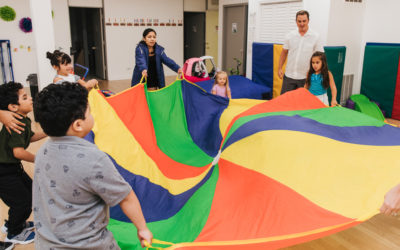As the parent or caretaker of a child on the spectrum you may hear plenty of terminology and verbiage to describe a lot of complex concepts and symptoms. One of those is Sensory Processing Disorder (SPD). SPD is a neurological disorder that can cause challenges with processing information from the five senses. It can also affect information from the sense of movement.
Those with SPD still feel and receive sensory information but the way they perceive it is abnormal. This abnormal interpretation tends to cause distress, confusion and discomfort which in turn can contribute to sensory overload or meltdowns. Although having a sensory processing disorder is not what determines whether someone is on the autism spectrum, many individuals with autism tend to face sensory processing challenges, making the two closely related. Understanding this relationship can help us understand certain behaviors that are the result of sensory processing challenges like tantrums and meltdowns.
SPD & Autism
Sensory Processing Disorder has been associated with autism for a very long time. For many years, SPD was even considered a symptom of autism until groundbreaking research revealed it to be a neurological disorder of its own. This research suggested fundamental differences in children with SPD versus children with autism. In other words, though it is possible to have both, a child with SPD is not necessarily a child on the autism spectrum and vice versa. One of the most striking points of this revelation was that children with SPD demonstrated greater brain disconnection than those with a full autism diagnosis. The main difference was where the disconnection occurred, meaning those with SPD had more disconnect in those parts of the brain related to sensory perception whereas children on the spectrum could experience it in connections essential to memory and facial recognition.
Instead, the relationship lies more within the challenges individuals on the spectrum and those with SPD face. For examples both individuals with SPD and those on the spectrum can demonstrate:
- Extreme sensitivity to lights, sounds and other sensory information at levels others may deem “normal”
- Anti-social behavior like withdrawing from social situations or away from peers.
- Peculiar or abnormal reactions to outside stimuli or an unwillingness to break from routine and visit new environments.
These are all related to the challenge of processing sensory input differently. Often, this can cause behaviors known as “meltdowns” in children on the spectrum especially.
Meltdowns
Understanding the challenge of a sensory processing disorder and those symptoms shared with children on the spectrum can shed light on some of the behavioral issues you may find yourself grappling with. A meltdown is an intense response to overwhelming situations, usually as a result of one or several environmental factors. Meltdowns are challenging because they tend to result in your child losing control of their behaviors and can seem similar to a tantrum. The main difference is that a meltdown is less related to behavior issues and is more of a form of communication that for many children on the spectrum, is involuntary or the only way for them to express their feelings of being overwhelmed. Meltdowns can come in the form of physical flailing, withdrawing from spaces and events where their peers are present, yelling, crying, kicking and more. Sensory overload can occur just about anywhere, but especially in newer environments where your child is most sensitive to the sensory information they’re receiving.
If your child is experiencing a meltdown we recommend:
- Giving your child plenty of time to recover from their sensory overload.
- Asking them if they’re okay, and attempting to have them communicate what triggered the meltdown.
- Giving your child plenty of space by creating a quiet, dim and safe space whenever possible.
- Reducing the amount of sensory information in the area by turning down music, dimming lights, etc.
Though it can be especially difficult to deal with a meltdown in public, the more you practice handling them, the better you will be at identifying potential triggers for your child. For example, it may be loud noises that trigger your child more so than other types of stimulation, so you know when you’re going to an event, party or other space with loud music or noise to bring headphones, earplugs or ask the organizer of the event to ensure the volume is kept modest. If it helps, we recommend taking notes after your child experiences sensory overload, so you can find the similarities of the environments and start a list of potential triggers.
Once you’ve nailed those down, we also recommend communicating some strategies for your child to try when they feel sensory overload coming on. This can be as simple as removing themselves from a room for as long as they need to to calm down. Practicing those strategies helps avoid meltdowns while also building on your child’s independence.
If you know your child struggles with sensory processing, we recommend seeking out sensory-friendly activities as much as you can. We can only do our best to learn the “why” behind our children’s behaviors in an effort to support their independence and growth. For more autism-related tips, news, and stories be sure to keep up with us on our Facebook, Twitter and Instagram and feel free to reach out via our contact page to learn more about our services.



